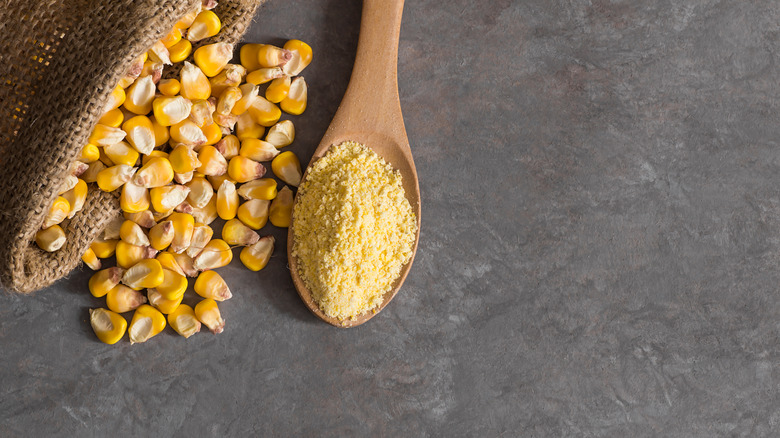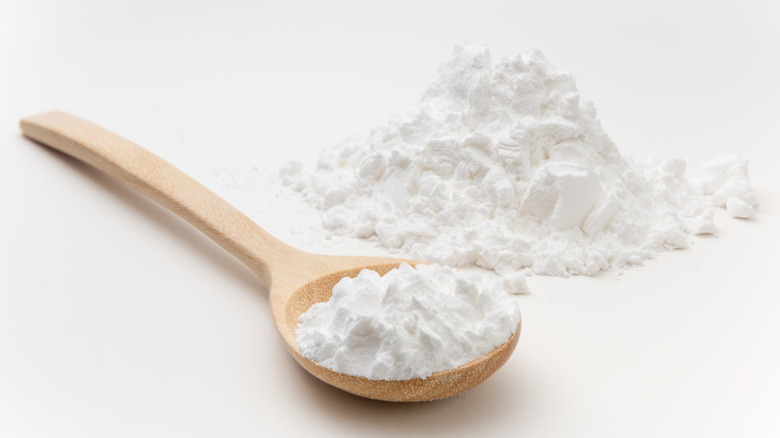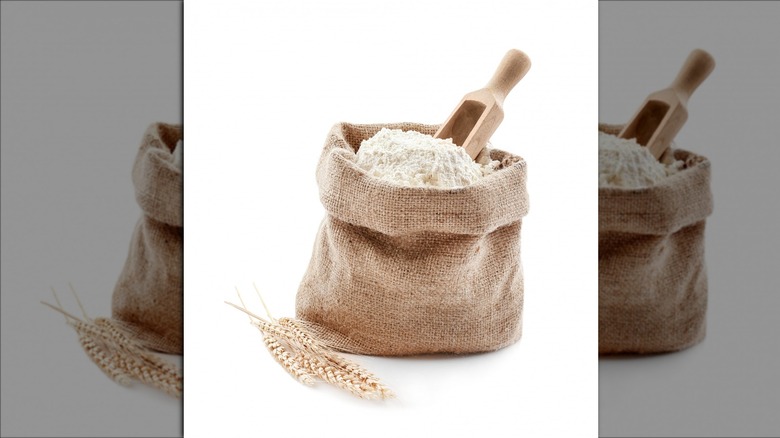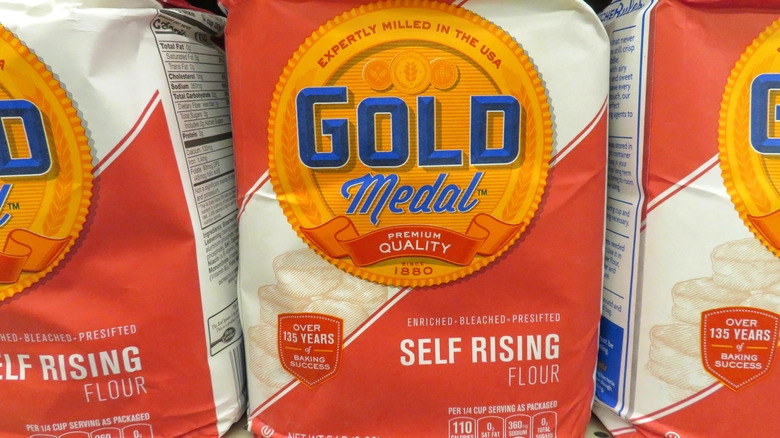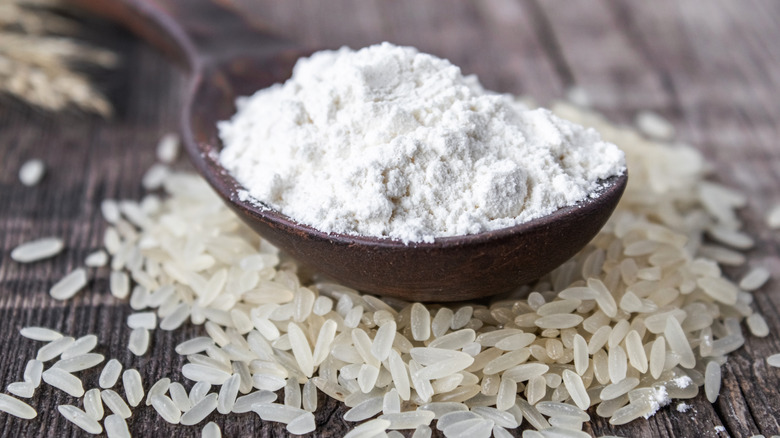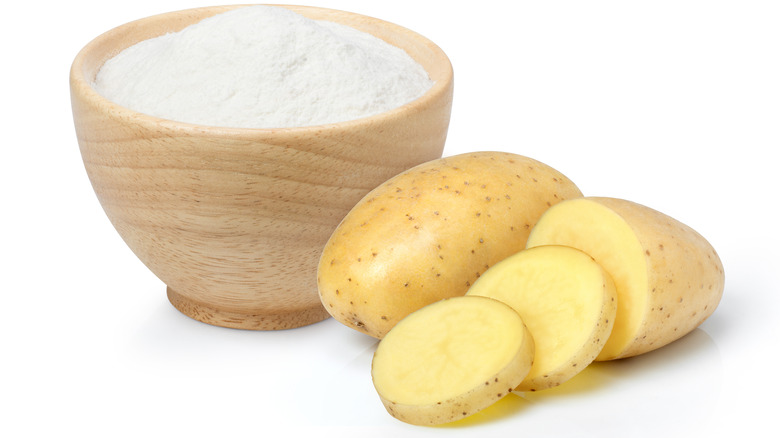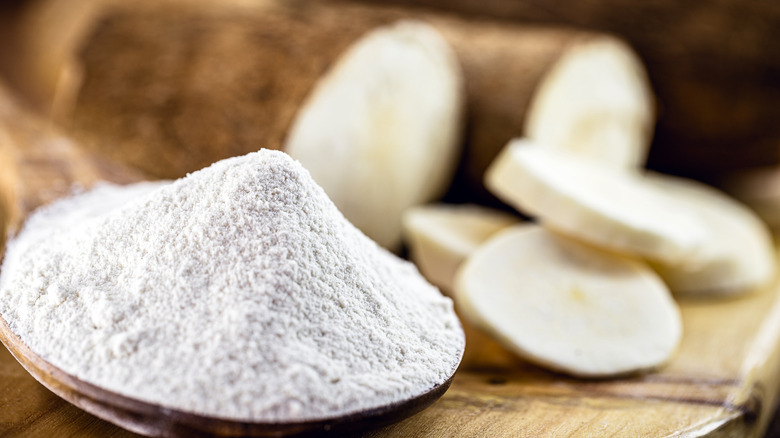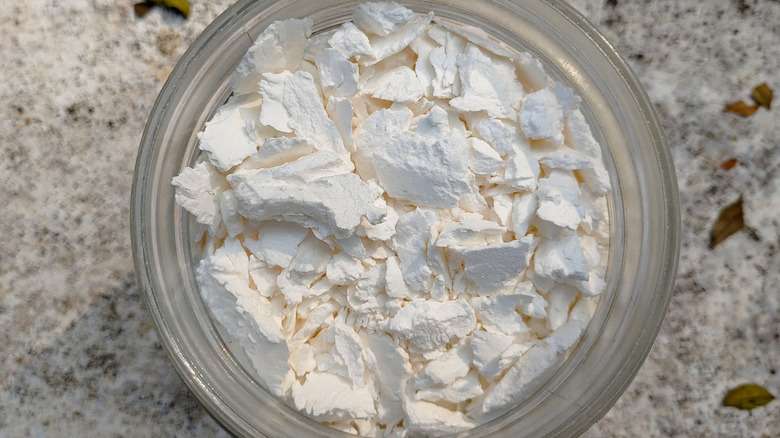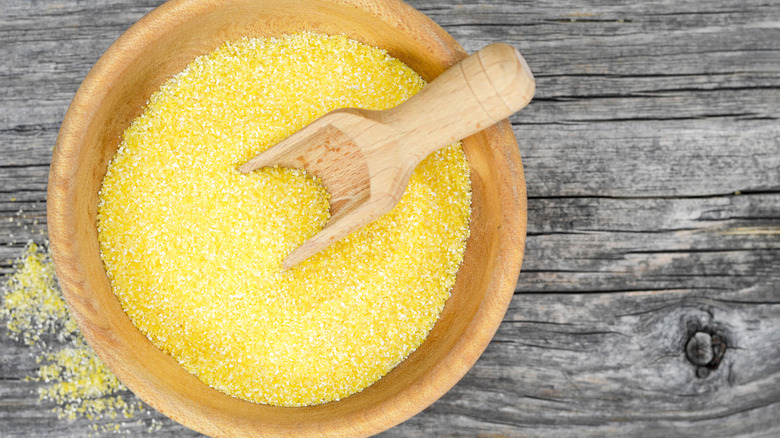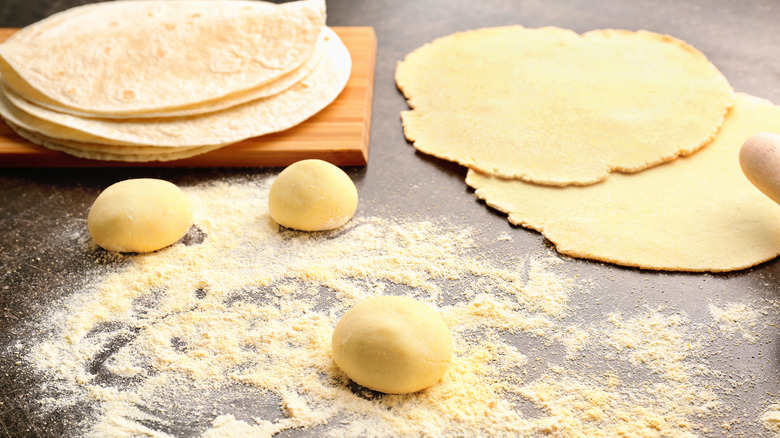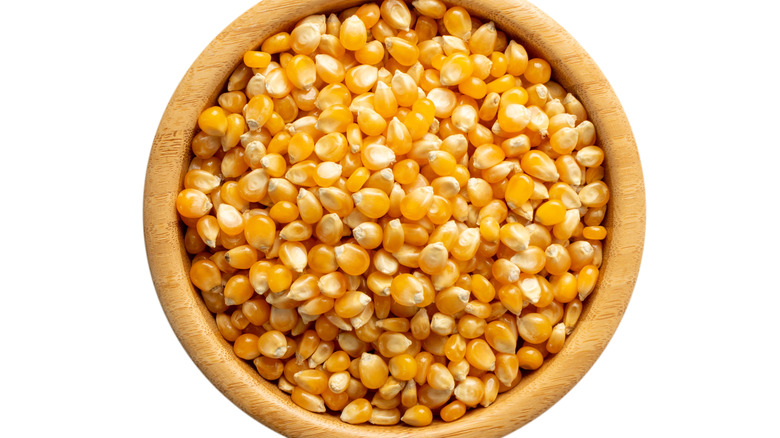10 Best Substitutes For Corn Flour
Before discussing the best substitutes for corn flour, we need to get into what, exactly, is meant by this term. If you see corn flour called for in a recipe, your first step should be to determine whether that recipe originated in the United States or the United Kingdom. As Healthline explains, in the U.K., as well as in Ireland, Israel, and possibly several other countries, corn flour is used to refer to something that we, in the U.S., call corn starch. Confusingly enough, what we call corn flour, they call cornmeal.
Corn flour, as we know it in this country, is a type of flour made by grinding whole corn kernels into a yellow powder. In recipes, it's often used in much the same way as you would use wheat flour. Corn starch, on the other hand, is much more refined. It is white in color and is typically used as a thickener. Corn flour is also more nutritious than is corn flour, as it contains fiber, protein, vitamins, and minerals in addition to starch. It is said to have a sweet, earthy taste, and adds both flavor and texture to muffins, waffles, cornbread, and other types of baked goods. So what should you use in its place if you happen to be fresh out?
1. Cornstarch
Okay, having established that cornstarch and corn flour are not the same things, we're still going to acknowledge that there are times when cornstarch can be swapped with corn flour in a recipe. Not in baking, no (unless your recipe is a British one), but if the corn flour is primarily meant as a thickener, The Spruce Eats suggests that cornstarch makes a pretty good swap. It does say, though, that cornstarch won't work as well as corn flour would in a really acidic sauce or fruit filling. Cornstarch can also be used in place of corn flour if you're using it as a coating before deep-frying.
If you are using cornstarch to replace corn flour as a thickener, you'll only use half the amount the recipe calls for since the all-starch cornstarch has superior thickening powers. (Pro tip: mix the cornstarch with a small amount of cold water before blending it into the liquid you're trying to thicken.) If you are using cornstarch to coat foods you're going to be frying, you can do a 1:1 swap for corn flout, or else you can use a 50/50 mix of cornstarch and corn flour if you're just trying to stretch the flour a bit farther.
2. Wheat flour
Most of the flour we use is made from ground wheat berries or seeds, which is all that business at the top of the wheat stalk. According to the Utah Farm Bureau, either the wheat is ground as is, in which case we get whole wheat flour, or else the brown outer shell known as bran is removed. The refined white stuff that results from this operation is good old all-purpose flour.
If you'll be using either type of wheat flour in place of corn flour, you'll need to double the amount of flour to use it as a thickener. If you use it as a coating for fried food, you'll use the same amount, but expect the results to be less crispy and a bit chewier. Foods Guy says that wheat flour can replace corn flour 1:1 when it's used in baking, and says it works quite well to replace corn flour used for making tortillas.
3. Self-rising flour
Self-rising flour is also a type of wheat flour, but one that contains a few extra ingredients. According to the flour experts at King Arthur, this Southern cooking staple is just all-purpose flour with some added baking powder and salt (via the King Arthur Baking Company). It can be used to substitute for corn flour in much the same way that either whole wheat or all-purpose flour can, although depending on how you use it, you may need to do a tiny bit of tweaking to your recipe.
If you use self-rising flour in place of corn flour as a thickening agent, you'll need to use double the amount in order to get the same thickening power. As a coating for fried foods, just swap it out one on one. In either case, the amount of flour you're using shouldn't be significant enough for the added salt and baking powder to make much difference. If anything, that wee bit of baking powder might add some extra crunch to your fried foods. If you are using self-rising flour in place of corn flour for baking, you would use the same amount, but you might want to reduce the salt in the recipe by ¼ teaspoon per cup of flour and any baking powder by 1½ teaspoons per cup.
4. Rice flour
Rice flour, which is commonly used in Asian cooking, is made from finely-ground rice, but it has more of a starchy, powdery consistency than does corn flour. While most rice flour is made from white rice, Foods Guy says that brown rice flour is also available, and this is something the site recommends as a (possibly) healthier alternative to traditional rice flour.
Rice flour isn't really recommended to substitute for corn flour as a baking ingredient, nor is it really recommended as a substitute when used for breading since it won't give your food the crunchy texture you'll get from corn flour. When used as a thickener, however, it makes for a similarly gluten-free stand-in.
When using rice flour as a thickener in place of corn flour, you'll use double the amount since it, like wheat flour, doesn't thicken to quite the extent that corn flour does. You'll also need to mix it with a few spoonfuls of cold or hot water before adding it into a soup or sauce in order to prevent lumps from forming.
5. Potato flour
Yet another gluten-free type of flour comes from potatoes. In order to make potato flour, Substitute Cooking says fresh potatoes are crushed to a pulp and dried, then, instead of being flavored and extruded into Pringles or a similar snack product, are crushed into a powder. One thing that makes potato flour such a good substitute for corn flour is that it, too, gets a touch of flavor from its veggie of origin. Okay, so potato flavor and corn flavor aren't exactly interchangeable, as the flavor will be a different one (mildly potatoey and sweet, according to Spiceography), but it's enjoyable in its own way.
Potato flour is typically substituted for corn flour when used as a thickener and a breading. Unlike wheat flour, potato flour does a great job of absorbing excess water and thus thickening any liquid to which it is added. Swap it out 1:1 for corn flour, but add it a bit later in the cooking process so your soup or sauce doesn't get too thick, too soon. When potato flour is used to replace corn flour as a breading, just make a straight one-for-one swap – no additional precautions are needed.
6. Tapioca flour
One substitute for corn flour that may not have occurred to you is tapioca flour. Tapioca flour, as Healthline explains, is made from the cassava root. Many of us are more familiar with tapioca in its pearl form when it is used to make puddings and boba, but tapioca flour is also used for making gluten-free baked goods and to thicken soups.
As a substitute for corn flour, tapioca flour isn't really recommended as a breading, nor is it often suggested as a replacement for corn flour when it's used in baking. As a thickener, however, EpersianFood says tapioca flour works very well, indeed. And the site is definitely talking about corn flour as we know it in the U.S. because it describes the ingredient as being made from the whole corn kernel rather than just the starch.
To substitute tapioca flour for corn flour, simply double the amount used in the recipe. This is necessary because tapioca doesn't absorb moisture to quite the same extent that corn (and potatoes) do.
7. Arrowroot
Arrowroot powder is another starch made from a tropical plant. In this case, it comes, not too surprisingly, from the arrowroot plant. It is often used in a similar fashion to cornstarch (not corn flour) and is particularly in demand as a thickener for clear liquids, as it tends not to make them cloudy. It is also called for in some baking recipes, but Foods Guy notes that arrowroot doesn't make for much of a corn flour substitute when it comes to breadmaking. It also doesn't mention whether arrowroot powder can be used for breading, but they do recommend it in place of corn flour when it is used for its thickening properties.
Arrowroot actually thickens more quickly than corn flour does, so you only need to use 2 teaspoons of arrowroot in place of each tablespoon of corn flour. You should also mix the arrowroot powder with cold water before adding it to any dish so it will combine more readily with the other ingredients. One thing to note about arrowroot powder: it thickens quickly, but the effects don't always last too long. Once your sauce, soup, fruit filling, or whatever it may be gets thick enough, you should remove it from the heat right away.
8. Cornmeal
Cornmeal makes for a rather obvious substitute for corn flour – American corn flour, that is. It really can't be swapped out for cornstarch (aka British corn flour) in most cases. Cornmeal, like corn flour, is made from whole corn kernels that have been ground into a powder, and it, too, is used in gluten-free baking and for recipes where you want that distinctive corn taste such as in cornbread or that old-timey breakfast favorite, johnnycakes. Where cornmeal differs from corn flour is that it is often a coarser grind, although cornmeal varieties available on the market range from very coarse to quite fine.
If you are looking to swap cornmeal for corn flour in baking, you can do so on a cup-for-cup basis, although Recipe Marker suggests that the finer grinds make for a better replacement. One thing you could do, if you're inclined towards a little culinary experimentation, is to put your cornmeal in the blender and see if you can't grind it into something more closely resembling corn flour.
9. Masa harina
Masa harina is a popular product that you can find in any Hispanic grocery store and in quite a few mainstream ones these days, as well. While masa harina is a type of flour made from corn that's even referred to as "corn flour" at times, there are a few extra steps involved in its production that make it quite different from corn flour as the term is used here.
Before being dried and ground, the whole corn kernels are soaked in calcium hydroxide and then ground to make a corn dough (via Mexican Please). The dough itself gets dehydrated, and this makes masa harina. Recipe Marker says that masa harina is known for having an especially fine texture. The site names it as one of the best substitutes for corn flour, particularly when used in tamales and tortillas where it can help them to achieve a light texture while the food still manages to be thicker.
Recipe Marker didn't provide a specific substitute ratio, so it might be a good idea to experiment, trying a 1:1 swap and adjusting if needed.
10. Homemade corn flour
Has it ever occurred to you that it's possible to create DIY versions of even some of the most basic pantry ingredients? Well, maybe not all of them, unless you've got a greenhouse to grow your own sugar cane or a wheat field in your backyard. Corn flour, however, is one of the easier ingredients to make on your own. Sure, there's a hard way to do it: sundry ears of fresh corn, strip the kernels from each cob, then grind them up to a flour-like consistency. If you don't want to go through all that trouble, though, Foods Guy says there's also a super-easy shortcut, at least if you've got the proper equipment.
Making your own homemade corn flour will require a bag of plain, unflavored, unpopped popcorn and a super-high-speed heavy-duty blender, such as the Vitamix 5200 (which costs $487 on the Walmart website at the time of this writing). Fill the blender halfway with popcorn kernels, whizz until flour-like, then store your DIY corn flour in an airtight container in the fridge or freezer to ensure freshness. Sure, you just spent nearly $500 to make 2 pounds of flour, but it was kind of fun to do. Plus you now have a really cool blender to make turbo-charged margaritas and stuff!
